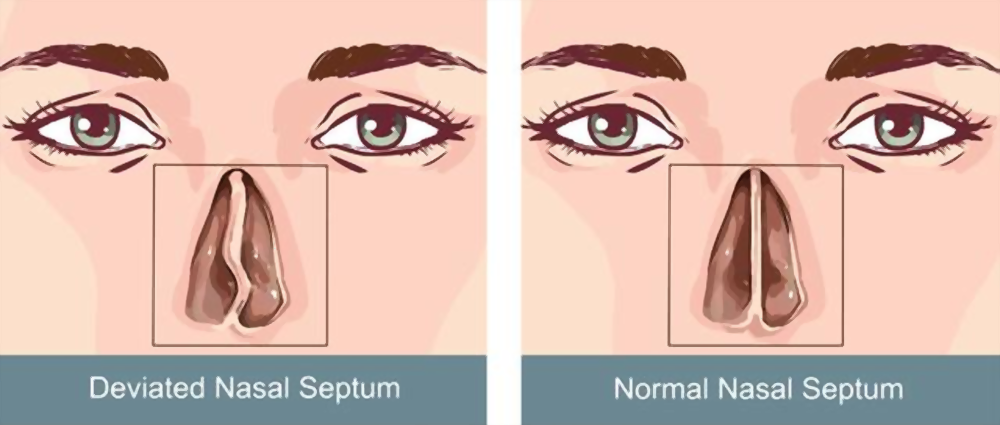
deviated nasal septum
- By Admin
- 23 January 2020
What is deviated nasal septum?
The nasal septum is the bone and cartilage in the nose that separates the nasal cavity into the two nostrils. A deviated septum refers to a nasal disorder where there is a displacement or misalignment of the top of the cartilaginous ridge to the left or the right, causing obstruction of the affected nasal passage the septum. It is estimated that this disorder is prevalent in 80% of the population, most of them being unnoticed. It is treated as a medical condition only in severe cases.
The nasal septum deviation may be present at birth occurring during fetal development or injury during childbirth. The septum deviation in adults occurs with an injury or trauma to the nose. The DNS caused by birth is smooth and often curved in the shape of S or C, whereas that caused by an injury is quite irregular in shape and may include minor fractures in the septum.
Most septal deformities result in no symptoms, and you may not even know you have a deviated septum. More often, the deviated septum is mistaken for respiratory problems. Nasal obstruction being the dominant symptom, the other deviated septum symptoms include:
- Nasal bleeding
- Nasal congestion
- Noisy breathing during sleep
- Sinus infections
- Nasal spurs
- Facial pain
- Sleep apnea (in severe cases, it is a sleeping disorder where breathing repeatedly stops and starts in the sleep)
An ENT doctor can diagnose the septum deviation disorder after a thorough physical examination. Initial treatment of a deviated septum may be directed at managing the symptoms. The treatment is based on the severity of the case. While most of them can be treated by medication, surgeries are recommended for severe cases. Commonly recommended deviation septum treatments include:
Managing symptoms
Initially, the symptoms can be controlled by medication as insisted by the doctor. Commonly used medicines for DNS include:
Decongestants: They are medications that reduce nasal tissue swelling, aiding the breathing process. They are available in the form of pills and also as nasal sprays. Persistent or frequent usage of the nasal sprays may cause drug dependence and may worsen the symptoms after the medication is stopped. Oral decongestants have a stimulant effect and may cause you to be jittery as well as make your blood pressure and heart rate go up.
Antihistamines: They are medications that help prevent symptoms related to allergy, which also includes Rhinorrhea (commonly known as runny nose).
Nasal steroid sprays: Nasal corticosteroid sprays also aid in reducing the swelling in your nasal passage and help with drainage. It usually takes from one to three weeks for steroid sprays to reach their maximal effect, so it is important to follow your doctor's directions in using them.
Surgical treatment
If the symptoms are still prevalent after the medication, the surgical methods are to be opted. The most recommended nasal septum surgeries for severe cases is septoplasty.
Septoplasty is a procedure where the nasal septum is straightened and repositioned in the center of the nose. The removal of excess bone or cartilage of the septum is also involved in this process.
The level of improvement from the surgery depends on the severity of the deviation. The surgery is preferably done after the age of 15, when the growth seizes. Significant symptoms like the nasal obstruction can be completely removed, but the allergies can't be cured entirely with surgeries.
The surgery may last for around 1 hour and complete recovery anywhere in between 2days to 4 weeks. Nasal congestion, pain, drainage, or swelling may occur within the first few days after the surgery. The reoccurrence of symptoms in the long term after surgery may not be due to DNS.
Rhinoplasty
It is also known as nose job. Rhinoplasty is the surgery to reshape the nose. It involves modifying the bone and cartilage of your nose to change its shape or size or both. Sometimes, a rhinoplasty, or "nose job," is combined with septoplasty to improve the appearance of the nose. This procedure is known as septorhinoplasty. Septoplasty may also be combined with sinus surgery.
Depending on certain factors, such as age at surgery and intensity of the misalignment, repetition of procedures or surgeries may be necessary.
The deviated septum treatment costs depending on factors like severity of the symptoms, procedure opted, and insurance coverage. It varies from one city to another within a country. The surgery cost may range around a few lakhs.